Solar and Wind Power Potential in Bangladesh
Wind energy potential in Bangladesh is over 20,000 MW, the wind speed being < 7 m/sec.
Global Climate Scope ranks Bangladesh in the 41st position from all observed markets in terms of attractiveness for renewable energy investments. The segment the country is lacking most is experience. However, considering the stable fundamentals and the significant opportunities, the future of renewable energy potential in Bangladesh looks bright. Additionally, and importantly, there are high-potential investment opportunities. The country’s current situation places investors in its renewable energy transition in a perfect position to be rewarded once the boom starts.
The State of Renewable Energy in Bangladesh
Bangladesh’s installed renewable energy capacity is 650.53 megawatts (MW). Solar making up 416 MW, with hydropower producing 230 MW. The total figure was up from 579 MW in 2018. The jump isn’t significant, but it marks a trend for what’s coming next. For now, solar power dominates the renewable energy mix in Bangladesh. Wind power, for now, remains at near-zero levels. By the end of 2021, the government is planning to reach at least 10% in renewables contributing to its total energy mix. Currently, the figure is standing at only 3%.
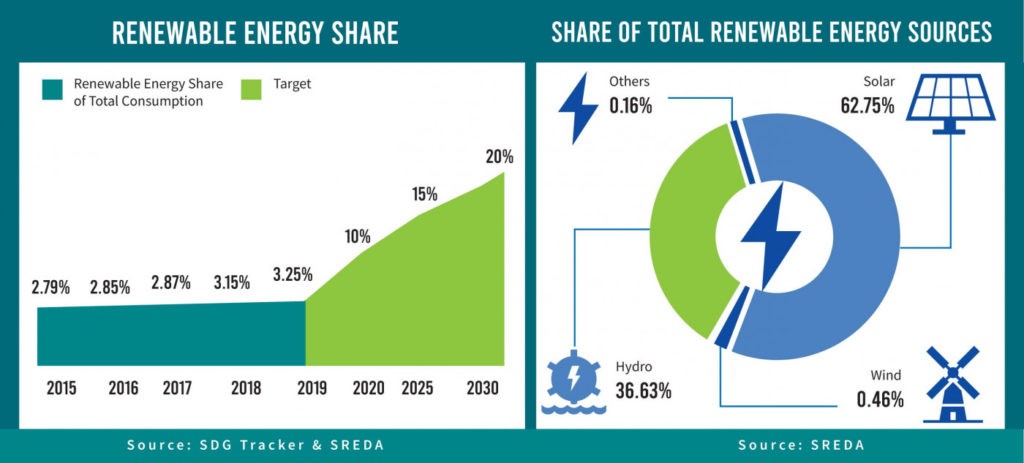
Solar Energy and Wind Power Potential in Bangladesh
While renewable energy’s share in the country’s power mix remains negligibly low, there is massive potential for solar and wind energy in Bangladesh. A report on the renewables technical capacity found that Bangladesh could deploy up to 156 gigawatts (GW) of utility-scale solar and 150 GW of wind.
Solar Energy Potential in Bangladesh
According to estimates, Bangladesh receives considerable amounts of solar radiation with 1,900 kWh/m2 per year. Daily, this figure translates to 4 to 6.5 kWh/m2.
Recently, the government issued a National Solar Energy Roadmap (SREDA) draft. It recommends a new solar target to address the sluggish clean energy progress. The aim is to have up to 40 GW by 2041, with 40% coming from rooftop solar. If the government prioritises the accelerated action plan, by 2041, Bangladesh could see a solar power potential making up 50% of its installed capacity.
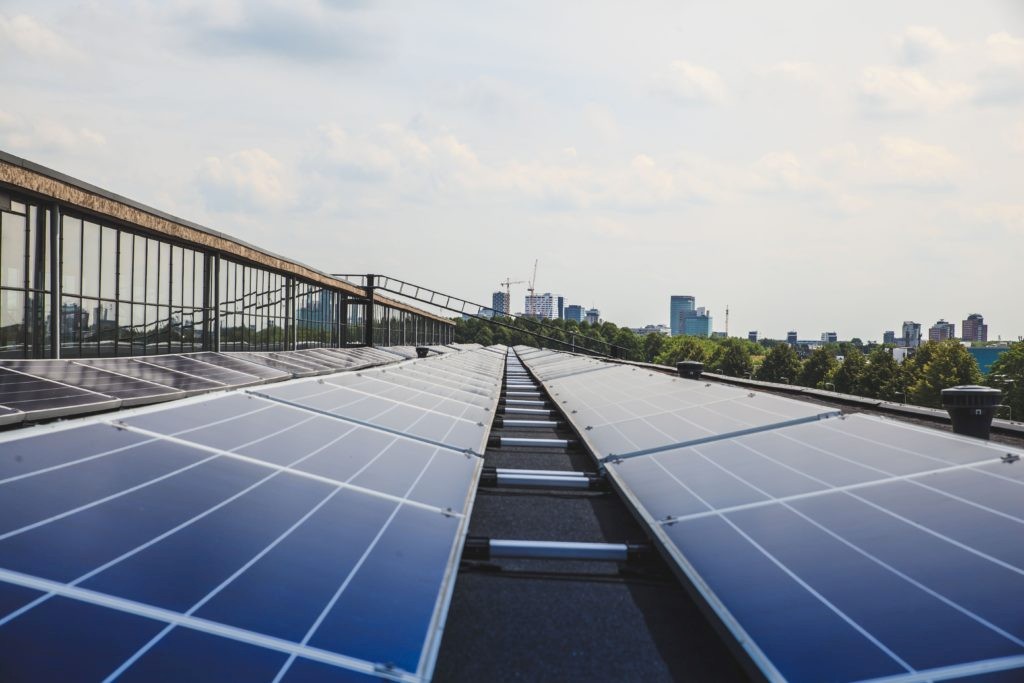
Hydro power is electricity produced from the movement of water.
Additionally, with an estimated 1,500 km2 of ponds, Bangladesh has a significant potential for floating solar. According to estimates, even utilising only one-third of the ponds for solar installations can generate 15 GW. Furthermore, Bangladesh also has 2,500 km2 of shallow water areas. Installing floating solar on just 10% of these areas would generate 25 GW. Big lakes like the Kaptai and the thousands of kilometres long river pockets could add 20 GW.
Regarding land-based options, it is calculated that Bangladesh has around 5,000 km2 of potential for roof systems. Fulfilling just 10% of this could generate 25 GW.
Wind Power Potential in Bangladesh
The U.S. National Renewable Energy Laboratory (NREL) concluded that Bangladesh has significantly more wind power potential than previously thought, especially at a hub height of 140 to 160 metres. The areas with the highest potentials reaching 724 km, like the coastline along the Bay of Bengal, Kuakata, Sandwip, and St. Martin. Wind power installation in these areas would solve a lack of energy access for locals who have remained off the grid.
The government is already beginning to move in that direction. In December 2020, it approved a major 55 MW wind power project in Mongla. Other projects are also in the pipeline.
The Challenges Facing the Solar and Wind Power in Bangladesh
The biggest challenge facing the renewable energy transition in Bangladesh is the switch from coal to liquefied natural gas (LNG). According to IEEFA, such a move is unnecessary as it will only slow down the clean energy transition.
Another obstacle is the overcapacity problem that had remained unaddressed for years.However, a switch in focus from coal-and LNG-fired power to renewables could successfully address this.
Financial and project development challenges also remain. According to the Asian Development Bank (ADB), the local banking sector cannot provide long-term financing or due diligence required for renewable energy development.
Another often-cited challenge is land scarcity. However, experts in the field disagree. Aside from the potential locations for solar and wind power development mentioned above, the IEEFA says that the amount of land suitable for renewables in Bangladesh is likely much more than previously assumed.
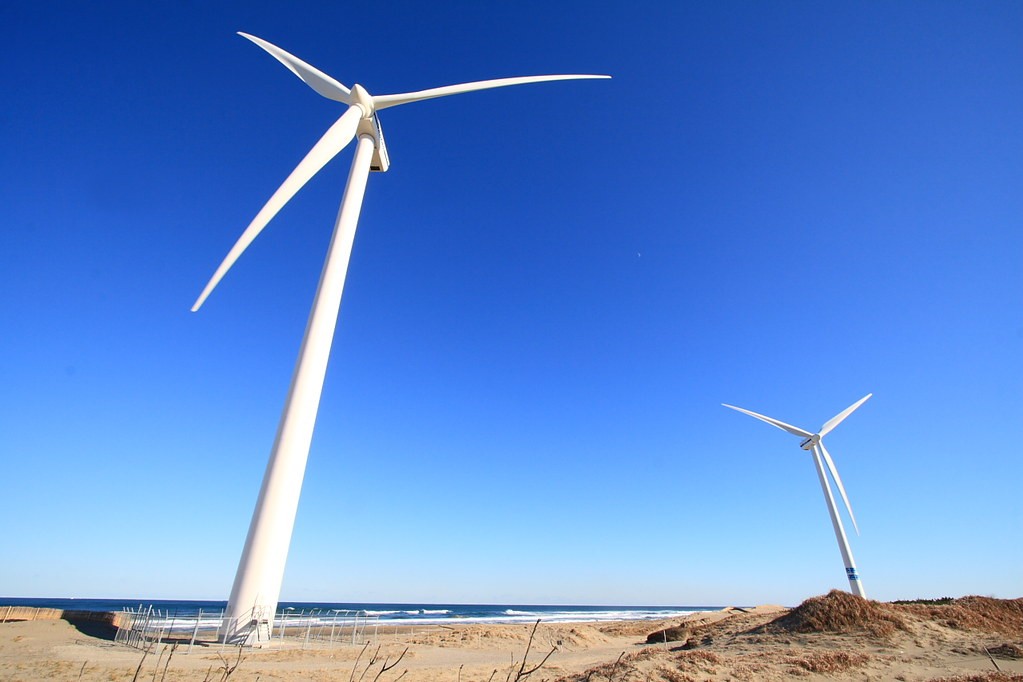
Photo by skyseeker
The Future of Renewable Energy in Bangladesh
All the triggers for a successful clean energy transition in Bangladesh are present. Renewables a cheaper and come with more stable prices. This can help it regain control over its power sector, cut capacity payments and meet growth expectations.
Bangladesh’s renewable energy investment opportunities will grow. The first places would be in the power plant development sector. Additionally, this would complement niches like solar power production. Due to the relatively lower labor cost and the growing industrial prowess of the country, experts project that the local manufacturing of floating pontoons, solar panels, and supporting accessories will experience a significant boom in renewable energy.
- Around 51 per cent of the capacity is natural gas-fired, while 27 per cent is from furnace oil, 6.0 per cent from gasoil or diesel and only 2.0 per cent from hydropower and solar, with another 5.0 per cent imported from India.
- The share of wind energy is almost zero.
- The under-trial Cox’s Bazar plant is, however, not the first wind-based power facility in Bangladesh.
- The country built its first wind-powered plant near the dam along the Muhuri river in south-eastern Feni district 18 years ago in 2005.
- The state-backed BPDB built the 0.9 MW plant.
- The second 2.0 MW plant was built three years later on Kutubdia island in the Bay of Bengal in Cox’s Bazar.
- But both plants lie idle for lack of supervision and interest from the power development board.
- Apart from the trio, Bangladesh has been working to install around a dozen more such plants with a total 1,000-MW generation capacity, said Power Division joint secretary Nirod C Mondol, who looks after renewable energy issues.
- Three more under-construction wind plants with a cumulative capacity of 102 MW in Sirajganj, Bagerhat and Chuadanga districts are due for completion by 2024.
- The process of selecting contractors for a 50-MW wind project in Chandpur Sadar and a 30-MW plant in Feni are also in the pipeline.
- Moreover, tariff negotiations are well underway to build a 200-MW plant at Chokoria in Chattogram, Mr Mondol told the FE.
- The technical evaluation for building a 100-MW plant at Banshkhali is underway. Another proposed 100-MW plant in Patuakhali will be sent to the evaluation committee soon, he mentioned.
- The US-DK Green Energy also submitted a proposal to Power Division for an extension of its power plant to double the capacity to 120 MW, said Mr Mondol.
- In July, a joint venture of two Danish renewable energy investors and developers-Copenhagen Infrastructure Partners (CIP) and Copenhagen Offshore Partners (COP)-also submitted a $1.3-billion investment proposal to develop a commercial wind-based project offshore.
- Initially, it aims to produce around 500-MW power.
- Once implemented, this offshore project will be the first of its kind in Bangladesh, and possibly in South Asia, enabling a technology transfer that would accelerate the learning curve for this nascent industry and reduce barriers to entry for future projects.
- The findings of a preliminary study suggest that hundreds of direct and indirect jobs could be created during the construction phase, in addition to dozens of permanent positions during the 30-year operational phase of the project.
- The Danish giants have proposed Summit Group, a leading infrastructure operator and developer in South Asia and the largest independent power producer in Bangladesh, to join the consortium.
- The US Department of Energy’s National Renewable Energy Laboratory (NERL) conducted a study on Bangladeshi wind energy potential several years back.
- The 2018 study ‘Assessing the Wind Energy Potential in Bangladesh: Enabling Wind Energy Development with Data Products’ said Bangladesh’s wind energy potential is at least around 30,000 MW.
- “Preliminary results demonstrate that for wind speeds of 5.75-7.75 metres/second, there are more than 20,000 square kilometres of land with gross wind potential of over 30,000 MW,” it concluded.
- The study found that nine locations across the country had an average wind speed of 5.0-6.0 metres/second at a height of over 60 to 80 metres above ground level.
- “We’re doing a feasibility study to build a number of new wind-based power projects on the basis of the NERL study,” Sustainable and Renewable Energy Development Authority (SREDA) chairman Munira Sultana told the FE.
- PM’s energy adviser Dr Tawfiq-e-Elahi Chowdhury also identified wind power as one of the energy sources to meet the country’s future energy demand against the backdrop of volatile fossil-fuel prices globally.
- The US-based Institute for Energy Economics and Financial Analysis (IEEFA) calls for an urgent overhaul of Bangladesh’s power-sector development with greater integration of renewable energy to enhance its energy security.
- The country should aim for renewables to make up 40 per cent of its total power-generation capacity by 2041, a target set by the government, said Shafiqul Alam, an energy finance analyst at IEEFA.
- “While once there was concern over the possibility of utilising wind to generate energy in Bangladesh attributable to the perception that we don’t have sufficient wind speed, later on, studies substantiated that Bangladesh could take advantage of wind speed in the coastal belt.”
- “We’re now concentrating on the utilisation of renewable energy,” said Mohammad Hossain, director general of the state-run Power Cell.
- “The Russian invasion of Ukraine has been an eye-opener, making us want to streamline local energy resources instead of depending on imports alone to meet the country’s energy demand.”
- The big thing is that renewable energy exploitation does not require any import of energy, said Mr Hossain. Bangladesh has been facing an acute dollar crisis since the beginning of the war in February 2022 mostly due to its over-reliance on energy imports to meet domestic demand.
- The long awaited Authorised Economic Operator (AEO) will start its operation on Sunday aiming to streamline import and export processes by providing a seamless clearance system.
- Finance Adviser Dr Salehuddin Ahmed will inaugurate the operation from a programme at rhe Multipurpose Hall of the National Board of Revenue (NBR).
- NBR Chairman Md Abdur Rahman Khan will preside over the event where chief adviser’s special envoy on international affairs Lutfey Siddiqui, Executive Chairman of the Bangladesh Investment Development Authority (BIDA) and the Bangladesh Economic Zones Authority (BEZA) Chowdhury Ashik Mahmud Bin Harun and Administrator of The Federation of Bangladesh Chambers of Commerce and Industry (FBCCI) Md. Hafizur Rahman will attend as special guests.
- Under this system, AEO-certified businesses will be able to directly transport cargo from ports to their factories or warehouses through a green channel without undergoing physical inspections.
- This will significantly reduce clearance time, lower costs, and improve overall efficiency in trade operations.
- According to NBR sources, the revenue authority has been working on implementing the AEO system for a long time. Compliant taxpayers will self-declare their tax status and conduct their own assessments before applying for AEO certification.
- A senior NBR official stated that the board has already issued 14 AEO certifications, with several more applications under review.
- The approved companies include: Popular Pharmaceuticals, Jihan and Shoeniverse Footwear, Fair Electronics, ACI Godrej Agrovet Private, Towa Personal Protective Device Bangladesh, Cutting Edge Industries, Omera Cylinders, MBM Garments, M/S Footsteps Bangladesh, GHP Ispat and BSRM.
- The NBR formulated the rules for this system in June last year and finalised the operational procedures in December. Additionally, it has upgraded its digital infrastructure to facilitate AEO operations.
- During a recent event on World Customs Day, the NBR chairman stated that once the system is introduced, compliant taxpayers will no longer face interventions from Customs authorities.
- “The imported goods will be directly delivered to their premises from vessels under the self-assessment system,” he said.
- He also mentioned that tax payments will be made through bank-to-bank fund transfers.
- The AEO system also provides international benefits if reciprocal agreements are in place with other countries, allowing certified businesses to enjoy similar privileges abroad.
- Introduced by the World Customs Organization in 2007, the AEO system aims to enhance global supply chains and expedite trade. Countries such as the US, the European Union, Japan, Singapore, India, and China have already adopted the system. India, for example, has more than 5,000 AEO-certified businesses.
- Bangladesh initially planned to introduce the AEO system in 2013, and its implementation became mandatory after two-thirds of World Trade Organization (WTO) members ratified the Trade Facilitation Agreement.
- In 2018, the NBR issued an official order, and in 2019, Square, Beximco, and Incepta Pharmaceuticals were granted AEO status.
- A 2022 NBR study on port clearance processes found that 72 to 78 percent of clearance time is spent on collecting and submitting import documents, highlighting the need for automation in trade facilitation.
- Currently, the NBR’s Customs Valuation and Internal Audit Commissionerate is reviewing applications from nearly 60 companies seeking AEO certification.
- According to the rules firms that want to be listed as AEOs must have an authorised capital of at least Tk 30 crore and paid-up capital of Tk 10 crore.
- Moreover, they must have a minimum annual turnover of Tk 10 crore for three years in a row.
- If the firm is not into manufacturing, their annual export or import must be of at least Tk 10 crore for three years in a row.
- However, the revenue board has included some criteria enabling small and medium enterprises (SMEs) alongside logistics operators to avail the status.
- One criterion for the SMEs says they must have conducted 20 annual shipments on an average over the past three years whereas another for logistics operators say they must have run operations in Bangladesh for the past four years.
- According to the rules, all companies will have to ensure at least 70 percent of transactions through formal channels like banks and mobile financial services.
- Interested companies must have operations of at least five years and clean records in duty, VAT and income tax payments.
- The inclusion of SMEs and logistics operators in the AEO framework is expected to further facilitate trade and enhance business efficiency in Bangladesh, reports UNB.
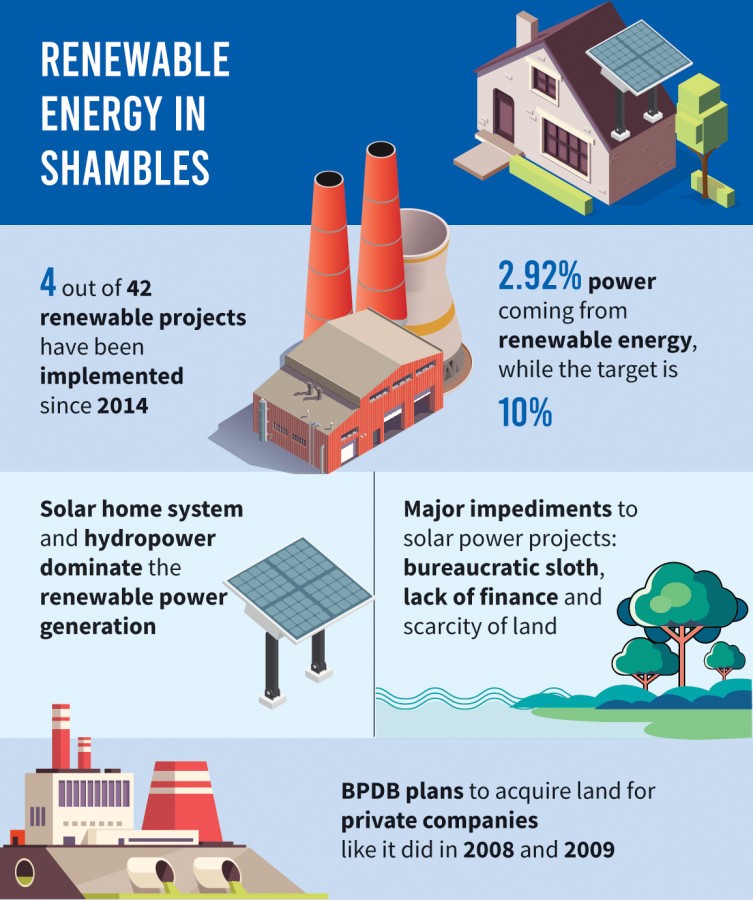
Vertical axis wind turbine
A wind turbine is an electrical device that converts the energy from the wind into electricity. These turbines are available in different types, sizes, and shapes. So the types of wind turbines are horizontal-axis wind turbine & vertical axis wind turbine.
The Vertical Axis Wind Turbine is a type of wind turbine that includes the rotor shaft and two or three blades where the rotor shaft moves vertically. So, this turbine movement is related to the spinning of coins on the edge. In this turbine, the generator is placed at the bottom of the tower whereas the blades are covered around the shaft.
The vertical axis wind turbine working principle is that, the rotors in the turbine revolve around a vertical shaft by using vertically oriented blades. So they generate electricity by using wind power. The wind operates the rotor which is connected to the generator, so the generator converts the energy from mechanical to electrical. Vertical axis wind turbine components are blade, shaft, bearing, frame & blade support.
The block diagram of a vertical axis wind turbine is shown below. The output energy generated from this can be used by any type of load. Here, the automatic lighting system is used as a load. This block diagram includes a Vertical Axis Wind Turbine (VAWT), gearbox, generator, battery, LDR circuit and LED.
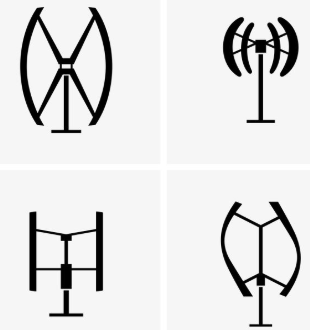
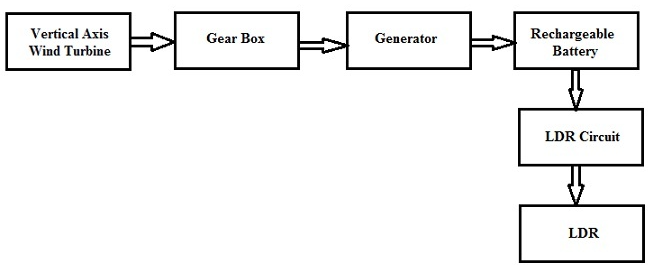
VAWT in Bangladesh’s Roads & Highways
This turbine works once the wind turns the turbine. Once this turbine rotates, then the generator will get it as mechanical input and generate the output as electrical energy. This turbine is arranged on the dividers of the highway roads. The shape of turbine wings is curved to get the wind for revolution from the 2-way road where the vehicle speed will make this turbine turn. Here, wind speed is used in different ways based on our requirements.
A vertical axis wind turbine is connected to the Gearbox which includes gears. This gearbox is directly connected to the electric generator shaft. This turbine will revolve once the wind blows and the gearbox in this system will enhance the turbine rotations internally by sending these rotations to the generator like a mechanical input. So the generator will generate the output as the electrical energy by using this input so that this output will be stored within the rechargeable battery.
In this way, electricity is generated and stored in the battery using the vehicle’s speed with the help of a turbine. The stored energy is used for the automatic lighting system. The LDR circuit uses a resistor, LDR (Light Dependent Resistor), transistor, battery, and LED (Light Emitting Diode).
The transistor collector terminal is connected to the LED’s negative terminal whereas the emitter is connected to the GND. Here, the resistor terminals are connected directly to the voltage source whereas the negative is connected to the LDR. When the LDR circuit is connected directly to the battery, then the LDR will start detecting the light. So when the intensity of light is decreased then LED will be activated automatically. So this LDR circuit is applicable in automatic ON or OFF light systems. When the light intensity of the Sun is decreased in the dusk then LDR will detect the light & supply the LED.
The vertical axis wind turbines are available in two types like Savonius Wind Turbine & Darrieus Wind Turbine.
Savonius Wind Turbine:
Savonius wind turbine includes the blades which are arranged around the vertical shaft within a helix form. One of the most significant features of this turbine is the solid wind-receiving area. These turbines mainly rely on the mechanism of flow resistance to make the rotors active which means, the dynamic force of the wind against the turbine blades thrust the rotor into revolution.
Simultaneously, the reverse side of the blades meets an aerodynamic resistance force. This is like when running or cycling, we experience the airflow coming opposite to us. Because of this, these turbines can simply turn fast like the wind speed. Please refer to this link to know more about Savonius Wind Turbine.

Types of Vertical Axis Wind Turbine
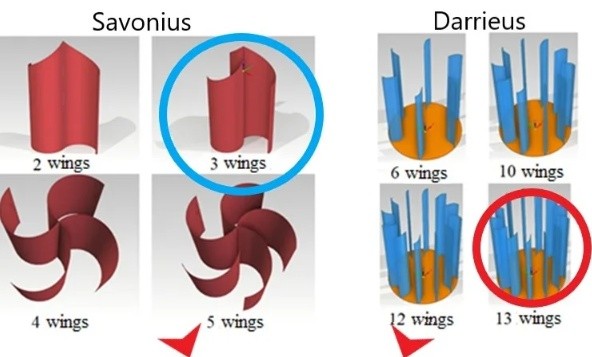
Darrieus Wind Turbine:
Darrieus wind turbine name is taken from the French inventor namely; Georges Darrieus. It is also called an egg-beater. These turbines include curved and long wings where each end of these wings is connected to the top and base of the rotor shaft.
These types of wind turbines use the aerodynamic force of the lift to revolve. By flowing around the construction, the wind will create suction on the front face of the wind turbine to drive the wings to revolve. Like Savonius turbines, these turbines do not experience as much drag due to the shape of wings. Once the revolution begins, these turbines will go faster to rotate faster than the speed of the wind. Please refer to this link to know more about Darrieus Wind Turbine.
Advantages:
The advantages of a vertical axis wind turbine include the following.
- Safety for manpower.
- They can generate electricity in any direction of the wind.
- It doesn’t require a strong supporting tower because the gearbox, generator & other components are arranged on the ground.
- As compared to horizontal axis turbines, these are cheaper to design.
- Installation is easy as compared to other types.
- These are portable so we can simply move from one location to another.
- These are designed with fewer speed blades to reduce the risk to birds & people.
- They work in all weather conditions like variable winds & mountain conditions.
- These are allowable where taller structures are not allowed.
- Its operation is simple so they don’t bother people in residential areas.
- These turbines can be arranged close to the earth so that maintenance, the cost for construction can be reduced.
- To operate these turbines, we don’t require any mechanisms.
- You can use the wind turbine where tall structures are not allowed.
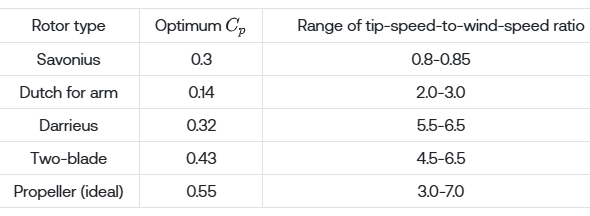
Advantages:
The advantages of a vertical axis wind turbine include the following.
- Safety for manpower.
- They can generate electricity in any direction of the wind.
- It doesn’t require a strong supporting tower because the gearbox, generator & other components are arranged on the ground.
- As compared to horizontal axis turbines, these are cheaper to design.
- Installation is easy as compared to other types.
- These are portable so we can simply move from one location to another.
- These are designed with fewer speed blades to reduce the risk to birds & people.
- They work in all weather conditions like variable winds & mountain conditions.
- These are allowable where taller structures are not allowed.
- Its operation is simple so they don’t bother people in residential areas.
- These turbines can be arranged close to the earth so that maintenance, the cost for construction can be reduced.
- To operate these turbines, we don’t require any mechanisms.
- You can use the wind turbine where tall structures are not allowed.

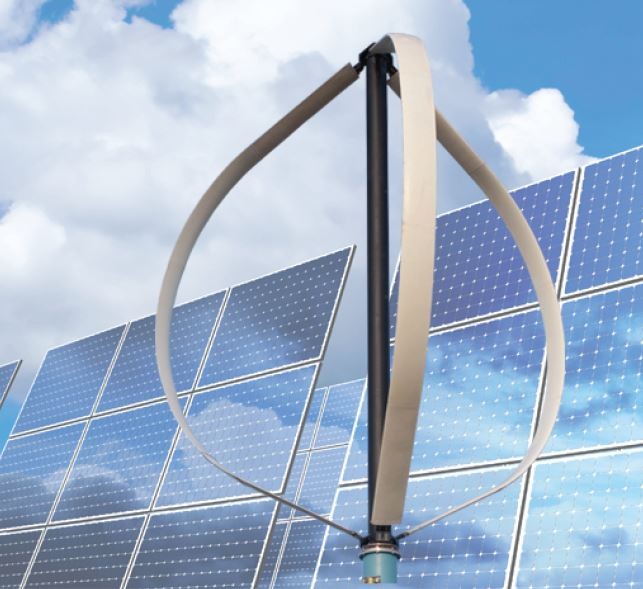
VAWT and Solar
Since wind power and solar power have different peak production times, the concept of putting these two renewable energy solutions together makes sense to increase the amount of daily production in one location. VAWTs over HAWTs (Horizontal Axis Wind Turbine) work better in this scenario for a variety of reasons.
First, the smaller footprint of a VAWT like the PT180 will mean more space for solar production. Second, maintenance won’t require access to huge cranes that will need their own offsets. Finally, the reduced shadowing of a VAWT over a HAWT should also be considered in a mixed facility.




wind turbine

Harnessing the Wind: How Wind Turbines Power a Greener Future
A wind turbine is a powerful symbol of clean energy and an essential part of the global shift toward sustainable power. It works by capturing the kinetic energy of wind and converting it into electricity. The core components include:
Blades – catch the wind and rotate
Rotor and shaft – transfer rotational motion
Generator – produces electrical energy
As wind turns the blades, the connected generator produces electricity without burning fossil fuels or releasing harmful emissions. Wind turbines are commonly installed in:
Open plains and coastal regions – for strong, consistent wind
Offshore sites – which offer higher energy output
Wind energy offers several key benefits:
Renewable and infinite
Low operational costs after installation
Minimal environmental footprint compared to fossil fuels
Despite concerns about noise, aesthetics, and bird safety, modern turbines are quieter, more efficient, and often part of carefully planned wind farms. Offshore turbines, in particular, reduce land impact and increase energy production.
Wind power continues to grow worldwide, helping nations cut carbon emissions and transition to cleaner energy. With ongoing innovations, wind turbines are expected to become even more efficient, affordable, and vital to our sustainable future.